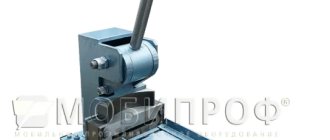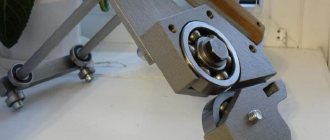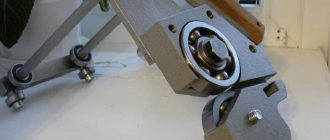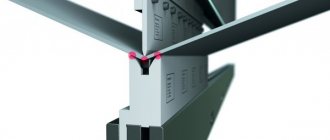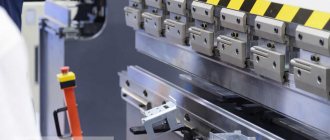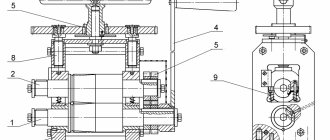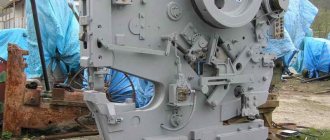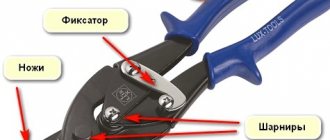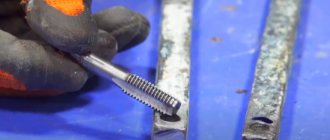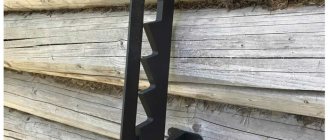Cutting metal with hand scissors
TO
category:
Metal cutting
Cutting metal with hand scissors
Next: Cutting metal with a hacksaw
Manual musical instruments are used for cutting steel sheets with a thickness of 0.5 - 1.0 mm and non-ferrous metals up to 1.5 mm. Hand scissors are made with straight and curved cutting blades,
According to the location of the cutting edge of the blade, hand scissors are divided into right and left.
Rice. 1. Elements of scissors
Right-handed scissors are those in which the bevel on the cutting part of each half is on the right side. Using right scissors, cut along the left edge of the product in a clockwise direction.
Left-handed scissors are those in which the bevel on the cutting part of each half is located on the left side. These scissors are used to cut along the right edge of the product counterclockwise.
When cutting a sheet with right-handed scissors, a mark is always visible on the metal being cut. When working with left-handed scissors, in order to see the mark, you have to bend the cut metal with your left hand, passing it over your right hand, which is very inconvenient. Therefore, sheet metal is cut in a straight line and along a curve (circle, rounding) without sharp turns with right-handed scissors.
The scissors are held in the right hand, grasping the handles with four fingers and pressing them to the palm; The little finger is placed between the handles of the scissors.
The clenched index, ring and middle fingers unclench, straighten the little finger and, with its effort, move the lower handle of the scissors to the required angle. Holding the sheet with your left hand (Fig. 2, b), feed it between the cutting edges, directing the upper blade exactly in the middle of the marking line, which should be visible when cutting. Then, squeezing the handle with all fingers of the right hand, except the little finger, they cut.
In Fig. 2, c, d shows techniques for working with scissors.
For straight cutting of metal of small thickness, hand scissors are used, one handle of which is clamped in a vice.
Chair staves differ from manual ones in their larger sizes and are used when cutting sheet metal up to 3 mm thick. The lower handle is firmly clamped in a bench vice or fastened (hammered) onto a table or other rigid base. For cutting sheet steel up to 3 mm thick, chair scissors with a stationary fastening are used (Fig. 3, c).
Chair shears are low-productive and require significant effort when working, so they are not used for cutting large batches of sheet metal.
Manual small-sized power music books. Innovator A. N. Vasiliev created small-sized power shears for cutting sheet steel up to 2.5 mm thick, rods, bolts (studs) with a diameter up to 8 mm. The dimensions of these scissors do not exceed the dimensions of standard hand scissors (Fig. 4). For cutting, the handle is secured in a vice, and the handle (working) is activated. The working handle is a system of two levers connected in series. The first lever, on one arm of which the knife is fixed, is connected to the handle with a screw.
Rice. 2. Working with scissors: a - position of the hand on the handle when cutting with scissors, b - with straight blades, c - with curved blades, d - cutting out the internal curved contour
Rice. 3. Scissors: a - chair scissors, fixed in a vice, b - hand scissors, fixed in a vice, c - chair scissors on a wooden base
Rice. 4. Small-sized power shears
Rice. 5. Lever shears
Rice. 6. Flying scissors
The second arm of the lever, which is the handle of ordinary scissors, is shortened and ends with a hinge, or the scissors handle itself. The end hinge of the handle is connected to the handle using a double-hinged link. This lever system approximately doubles the cutting force compared to conventional scissors of the same size. The scissor blades are replaceable and attached to the levers with hidden rivets.
These scissors also have a device for cutting rods with a diameter of up to 8 mm. The device has discs with holes mounted on scissor arms and is a regular scissors, but with specially shaped knives (hardened bushings). These knives are replaceable and are inserted into the disk socket. For cutting bolts (piles). in the bushings of one of the disks there is a groove (several threads), which protects the threads of the bolts from being crushed during cutting.
Small-sized power shears provide good cutting quality.
Lever shears (Fig. 5) are used for cutting sheet steel up to 4 mm thick, aluminum and brass up to 6 mm. The upper hinged knife is driven by a lever. The lower knife is stationary.
The knives are made from U8 steel and hardened to a hardness of HR.C 52 - 60. The sharpening angles of the cutting edges are 75 - 85°.
Before work, check whether the rubbing parts are lubricated, whether the lever moves smoothly, and whether there is a gap between the cutting edges.
When cutting metal, grab the handle of the lever with your right hand and smoothly move it to the upper position, while the upper knife 3 moves upward. Then the sheet is laid so that the left hand holds it in a horizontal position, and the cut line is in the field of view and coincides with the blade of the upper knife. By moving the hand, lower the lever with the knife down until part of the metal is cut through, after which the lever is moved to the upper position. Next, slightly lift sheet 4 with your left hand, move it along the line along the cutting edge of the upper knife and repeat the cutting technique until it is completely cut. The scissors provide a cut without dents, cuts along the edge and sufficient accuracy.
Fly shears are widely used for cutting sheet metal with a thickness of 1.5 - 2.5 mm with a tensile strength of 450 - 500 MPa (45 - 50 kgf/mm2) (steel, duralumin, etc.). These scissors cut metal of considerable length. Lever shears have a cast iron frame and table. A lower stationary knife is built into the table, and an upper movable knife with a curved cutting edge is fixed in a knife holder. The upper movable knife has a counterweight that balances the knife holder with the knife.
The size of the workpieces to be cut is pre-marked or limited by an adjustable stop, for which the stop is first set at the required distance from the cutting edge of the lower stationary knife. During cutting, the sheet is tightly pressed with its side edge against the stop, and with the other edge against the spring stop. After this, by turning the handle away from you, the sheet is pressed tightly from above with a clamping bar and, lowering the upper nose with knife holder 6, the workpiece is cut.
When lowered, the knife holder rests against a spring stop. Rearrangement of the stop is carried out using the handle.
Shears with inclined knives (guillotine) allow you to cut sheet metal up to 32 mm thick, sheets with dimensions of 1000 - 3200 mm, less often strip products, as well as sheet non-metallic materials.
What are metal scissors?
This device is designed to cut metal sheets and reinforcement. When compared with similar methods of working with metal, this cutting option has several obvious advantages:
- Cheapness. Mainly for the reason that you don’t have to spend extra money on consumables (cutting wheels and gas).
- The properties of the metal after cutting remain the same. Since the blades of the scissors do not heat up, and therefore do not in any way affect the structure of the metal sheet.
- Cutting time is much less.
- Ease of use. Cutting with such a simple tool does not require any special knowledge or skills from you.
- The tool does not require maintenance or special care.
- The scissors are very compact and portable.
Types of scissors for working with metal
Cutting sheet metal is not an easy task. However, scissors designed for this type of event allow contours to be made in various configurations.
To get the desired result, you need to make the right choice. The markets have a wide range of these tools, so before you give preference to one or another model, you should familiarize yourself with their direct purpose and technical characteristics.
Manual
This version of the scissors is designed for working with the following types of metal:
- steel having a diameter from 0.5 mm to 0.7 mm;
- roofing iron;
- metal tiles;
- non-ferrous metals, the thickness of which does not exceed 1.5 mm.
The product includes two short knives and two long handles, as well as an axle, screw and rivet that act as connecting elements. The cutting action of the tool occurs by closing the handles and, accordingly, the knives. The length of such a model can vary from two hundred to four hundred millimeters. Hand scissors can be either right-handed or left-handed, the first version cuts clockwise, the latter - vice versa.
According to the manufacturing method, metal scissors are divided into:
- forged;
- cast;
- composite - lever.
Forged products are high-quality tools; their strengths lie in the increased strength and wear resistance of the blade; their weaknesses lie in their high cost. Cast scissors are inferior to their forged counterparts in the qualities mentioned above. Composite lever models are more convenient than the first two options, this is due to the presence of a lever mechanism and a return spring.
Lever
These scissors are designed for processing sheet metal up to four millimeters thick, as well as corners, wire and rods. The model includes two flat-shaped knives, which are connected using a screw or axle. The lower cutting blade is attached to some workplace and remains motionless, and a handle is attached to the movable upper blade for comfortable work. To fix the material being cut, profile holes of different sizes are often made in the knife blades.
Currently, manufacturers offer an improved type of tabletop lever scissors, equipped with an adjustable stop that facilitates correct cutting and a lever. The lower knife has a sharpening angle of ninety degrees. The blade located at the top has a configuration characterized by convexity and curvilinearity. The movement of this canvas is carried out under the influence of a lever. During the cutting process, the material being processed is located on the lower knife, and the marking line is under the upper blade.
Guillotine
A similar device is used in large manufacturing enterprises, in workshops for processing material whose thickness reaches thirty-two millimeters, and for strip rolling. Guillotine shears operate on the same principle as lever shears, but in comparison they have the following differences:
- the presence of an electrical or hydraulic wire at the blade located at the top;
- big sizes.
One type of guillotine model is represented by hydraulic shears, designed for cutting metal sheets, cutting reinforcement, all kinds of cables and making holes in workpieces.
Machine
Manual models for cutting metal are not characterized by high productivity, for this reason they are used in single production. When carrying out mass work, the best option is to use mechanized (machine) shears. These products operate thanks to an electric drive.
Nibblers
Such scissors are called nibblers; they are quite common and represent a miniature press. They are usually used when working with profiled metal or corrugated pipes. The principle of operation of such tools is to displace material anywhere. Products can be equipped with additional blades for making holes. Nibblers allow both right-handed and left-handed placement of the cutting element.
This option is intended for work with small volumes. Its advantage lies in the convenient performance of figured cutting and processing of material in the transverse direction. Since nibblers are designed for cutting profiled metal, their weakness is the formation of curvature at the edge of the craft during the cutting process; this defect must be straightened upon completion of the work.
Roller
The purpose of this tool is to cut workpieces made of different metals. Their design is quite simple and their performance is high, making them ideal for use in workshops and manufacturing plants. The thickness of the material processed by roller shears should be up to one millimeter. The tool is most often used in the construction of fences and working with roofing materials.
The advantages of this product are its low weight, simple settings, and ease of use. Roller shears are distinguished by correct cutting, eliminating the formation of burrs and curvature. The design includes a power section and a pair of disc roller cutters capable of rotating in different directions, thereby pressing into the workpiece and cutting it. The cutting edges of the device are located in the same plane; after cutting, there is no need to clean the edge.
Electrical
Most versions of electric scissors resemble a grinder in appearance. Certain models fit comfortably in the hand due to the special shape of the body: narrow and elongated. Most tools are equipped with remote handles, which makes them easier to handle during operation.
For the manufacture of the body of these designs, ABS plastic is used, which is impact-resistant. In addition, electric scissors differ from each other in the design of the mechanism, due to the operation of which the material is processed.
According to the principle of operation, all electric models are divided into the following types:
- leafy;
- perforated (cut-out);
- splined.
Compared to hand scissors, such equipment has a number of advantages:
- automatic process;
- high quality and accuracy of work;
- ability to cut material with a thickness of 3 mm;
- high performance;
- no deformation of metal sheets during processing;
- ease of use, eliminating injuries and cuts.
For what purposes are metal scissors used?
- In the automotive industry. This includes the creation of flat rectangular blanks and shaped elements with turned sides and made holes.
- In construction. Creating parts for the roof and cutting metal elements to prepare the base of the building.
- At metal yards for cutting rolled metal to meet the various needs of residents.
- In the work of rescuers. Such scissors are quite often used for sorting out all kinds of rubble due to collapse due to bad weather.
- When dismantling various equipment and scrap metal.
- At home. The use of scissors greatly helps owners in minor repairs of metal structures and more.
Compliance with safety rules when working with tools
When cutting, you should always wear special construction glasses. They will protect your eyes and the area around them from possible small chips.
Also, when carrying out such work, it is necessary to wear cotton gloves to prevent the tool from slipping out of your hands. During the cutting process itself, it is strongly recommended not to place your hands or feet nearby, as an awkward movement can cause serious injury to the cutter.
Each of the types of cutting tools discussed in the article is designed for specific tasks. When choosing, you should always pay attention to the characteristics of such equipment. When working, always follow the established rules and safety precautions to protect yourself and anyone nearby from possible injury.
Electric scissors for fast and precise cutting of sheet material
Evenness and aesthetics of cutting with mechanical scissors is achieved only with the proper purchase of the tool. In addition to mechanical ones, manufacturers also make electric shears.
Such a tool does not need your power to cut the material, since the electric motor is now responsible for this.
Electric scissors come in the following types:
- Die-cutting or die-cutting - their design is fundamentally different from manual ones.
- Knife scissors are similar to mechanical scissors, and only 1 blade is responsible for their work.
Die-cut
They acquired this name because of their operating principle. They are used for cutting corrugated sheets and metal tiles when installing roofing. Their main advantage is their ease of use and operational efficiency.
When cutting sheets of steel or other alloys, no sparks are generated, plus the material does not wrinkle along the cut boundary.
- With these scissors you can cut sheets either in a straight line or create different patterns.
- If you intend to create a certain shape in the middle of the sheet, then the first step is to drill a hole and then start cutting from the middle.
When piercing steel in this way, the blade moves very quickly, so the sheet simply does not have time to deform.
Knife
They are very similar to conventional mechanical tools, only they are made of movable and fixed blades.
- The working blade moves thanks to an electric motor, performing cyclic reciprocating actions.
- These scissors are suitable for straight or curved cutting.
If the sheet is thin, then the edges may wrinkle in some cases, sometimes this is due to the fact that the metal is simply soft in itself. To prevent this from happening, knives should be sharpened periodically.
Punching devices
Like the previous type of tools, they belong to mechanical products. Their action is based on the vibrational reciprocating movement of the upper knife. It is driven by a rapidly rotating eccentric mounted on a shaft from an electric motor.
Such devices for cutting sheet metal make it possible to start the procedure both from the edges and from the center. There are no sparks during operation, which protects the material from damage. Therefore, nibblers can be used to cut profiled metal. To cut in the center, you must first make a hole in the sheet, into which you then insert the cutting edge.
The permissible thickness of the material is no more than 2.7 millimeters. Within one minute, a cut of three to six meters in length can be made. The tool is convenient, compact and productive. Therefore, it is very popular among professional craftsmen.
Main selection criteria
Execution option. Scissors are produced in right and left versions, which depend on where the lower knife is located.
Usually the tool is created with the lower blade on the left, so the tool is very convenient for right-handed people, but for left-handed people the reverse position of the blade is more in demand.
Material thickness
Always carefully read the manufacturer's notes, as he always indicates the permissible thickness of sheet metal that the tool can work with. If you do not take this point into account, then at best the handle will simply break; at worst, a splinter of the blade will injure you when cutting.
Blades
Chrome vanadium steel is the most popular material in the manufacture of metal scissors. Stainless steel knives are more valuable on the tool market, but, as a rule, such scissors are much more expensive.
Handles
The secure grip of the handle ensures comfortable and long-lasting work without chafing. A good handle should be made of durable plastic that can withstand enormous loads. It is important that the handles contain fragments of rubberized material, this way the handles will protect your hands from injury when slipping.
Length
Typically, the length of the handles varies from 17 to 37 centimeters; you need to choose depending on the regularity of work and the thickness of the metal.
Select the tool at your discretion; it is important to take into account the fact that the longer the handles, the less force you need to apply to make the cut.
Types of tools
Before you buy hand scissors for cutting thin sheet material, you need to understand their types. To carry out the relevant work on processing sheet steel, you need to take the appropriate tool, which will allow you to achieve the necessary results. What are the devices in question or their types, we will find out further.
- A straight cutting tool is the simplest type of device, which is designed for cutting large circles and straight cutting of material
- Mechanical with curved blades - used for cutting holes, as well as for obtaining cuts of different shapes
- Finger blades with thin blades - used to produce cuts of various shapes. The blades on finger scissors have different positions relative to each other. It follows that tools are divided into left and right, and depending on the task at hand, it is necessary to use the appropriate type of device
- Chair saws - used for cutting thick sheet steel. They cope with steel thicknesses up to 2-3 mm. When cutting thick sheet steel, effort must be made, so the design of the devices has a special bend. This bend is necessary in order to hook the tool to the workbench, thereby ensuring that the upper handle is pressed with high force, increasing the cutting force
- Power - another type of device for cutting sheet metal with a thickness of 2.5 mm. Power mechanical scissors consist of two levers, which are fixed using a hinged bracket. Power tool models come with replaceable discs and blades that can be used to cut metal rods up to 8 mm thick
- Lever scissors are professional models of scissors that are attached to a workbench. The design of such devices is such that one blade is movable and the other is fixed. The movable blade is driven by a handle on the tool. They are used for cutting aluminum, steel, copper, brass, etc. The maximum thickness of steel reaches 4 mm, and brass, copper and aluminum up to 8 mm
All types of scissors are divided into professional and amateur. They differ not only in price, but also in quality. Professional models are made from high-quality materials, so they are intended for constant use. They have a long service life and are 2 times cheaper than amateur ones. Amateur ones are intended for infrequent use, since low-grade types of steel are used for their manufacture.
Rules for cutting with scissors
When cutting sheet metal, it is important to consider the following operating rules and safety regulations:
- It is possible to cut metal sheets of small thickness without any additional design solutions. To do this, you need to lay the metal on a workbench, fix one end with your hand, and cut the other according to the markings.
- When cutting metal of considerable thickness, you should clamp one handle in a vice, in this case there will be a reliable stop. The pressure on the knives increases, and therefore you will be able to cut large sheets.
- If you are cutting wire with metal scissors, you must use gloves made of thick material.
- In order to protect your eyes from mechanical damage, it is important to wear at least glasses, but it is better to use a face mask.
- Fix the separated pieces of wire when cutting towards the workbench.
- You can give a piece of wire or sheet to other people only with the sharp ends facing you; this is done in order to protect the other person from accidental cuts.
We hope that you have carefully read our article, which means you can choose good metal scissors without any problems. All the best!
What to look for when choosing
When deciding on the choice of scissors for cutting metal, you need to know what kind of alloy is used and what its thickness will be. Not all handmade products can handle thick sheets.
It is necessary to decide on the tasks at hand, whether regular cutting or shaped cutting is required. If you need an electric tool, then you should pay attention to its power and the type of cutters. Most of the models presented have replaceable cutters.
This allows you to select scissors for a specific type of metal. The last thing to consider when choosing a product is its power. Electric motors also vary in number of revolutions. The more complex the cutting, the higher the power required.
Photos of the best models of metal scissors
Features of hydraulic products
The products are designed for cutting metal structures (rods, profiled iron, scrap, fittings) using an evenly distributed force along the length of the blade. Conventionally divided into two groups:
The first ones are also called manual. For example, the following are manual hydraulic shears NGR-20 “KVT”. Their purpose is to cut armored cables, fittings, and steel ropes. The main characteristics include:
- permissible thickness of the cut product is 20 mm;
- high-strength cutting blade (60-62 on the Rockwell scale);
- maximum force - 5 t;
- length - 36 cm, weight - 3.2 kg;
- the presence of a rotating guillotine type head;
- addition of a pressure release lever to the design;
- cost about 20 thousand rubles.
Large tools are bolted onto the base machine. Intended for:
- scrap metal cutting;
- recycling of cars, buses, trucks;
- dismantling of metal structures;
- cutting and recycling of rolling stock;
- cutting of boats, ships, boats.
Impressive hydraulic shears for cutting metal are available in several series. For example, AD class models dismantle steel structures, MP-T is suitable for longitudinal cutting of metal (sheet), DS for reinforced concrete, and so on.
Features of Sheet Shears
The operating principle is reminiscent of conventional household analogues. A static knife is mounted on a rigid support, and a movable knife is mounted on a perpendicular plane. The support zone is adjustable, allowing the user to select the desired gap between both blades to suit the thickness of the workpiece.
Sheet metal shears cut the workpiece only from the edge; from the middle the design will not allow. Shaped cutting is also difficult to achieve.
The demand for products is due to the correct ratio of the thickness of the sheet being cut and the cost. For example, sheet metal shears Makita BJS160Z cost about 10 thousand rubles, and have the following characteristics:
- maximum cutting thickness for steel - 1.6 mm, aluminum - 2.5 mm;
- minimum cutting diameter - 0.5 m;
- battery power;
- stroke frequency - 4300/min.
This tool is sufficient for standard home and garage work.
Domestic manufacturers offer products with similar parameters and lower prices. For example, sheet metal shears Caliber-Master ENN-500 with a maximum cutting thickness of 2.5 mm will cost the consumer 4 thousand rubles. However, user reviews indicate that foreign manufacturers (Makita, Bosch, Metabo and others) supply more reliable equipment to the market.
